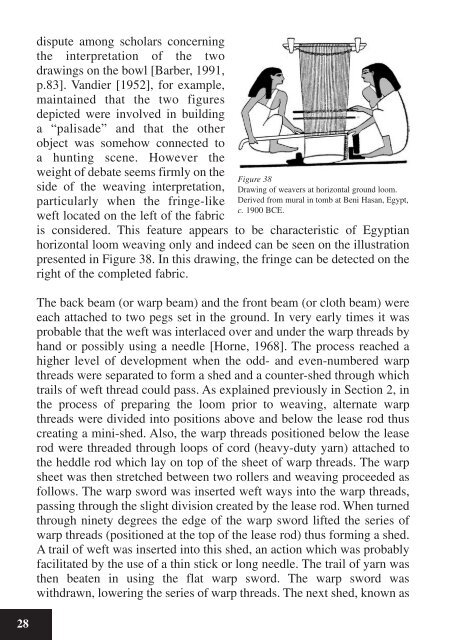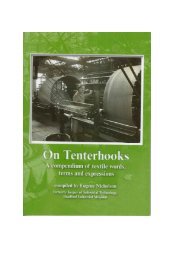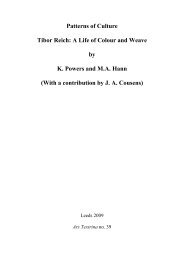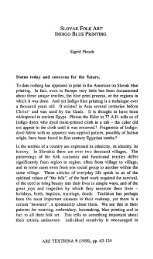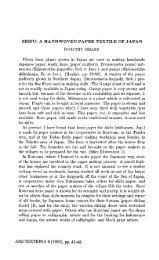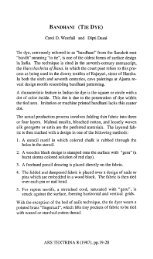Decorative Weaving Techniques - International Textiles Archive ...
Decorative Weaving Techniques - International Textiles Archive ...
Decorative Weaving Techniques - International Textiles Archive ...
You also want an ePaper? Increase the reach of your titles
YUMPU automatically turns print PDFs into web optimized ePapers that Google loves.
28<br />
dispute among scholars concerning<br />
the interpretation of the two<br />
drawings on the bowl [Barber, 1991,<br />
p.83]. Vandier [1952], for example,<br />
maintained that the two figures<br />
depicted were involved in building<br />
a “palisade” and that the other<br />
object was somehow connected to<br />
a hunting scene. However the<br />
weight of debate seems firmly on the<br />
side of the weaving interpretation,<br />
particularly when the fringe-like<br />
weft located on the left of the fabric<br />
Figure 38<br />
Drawing of weavers at horizontal ground loom.<br />
Derived from mural in tomb at Beni Hasan, Egypt,<br />
c. 1900 BCE.<br />
is considered. This feature appears to be characteristic of Egyptian<br />
horizontal loom weaving only and indeed can be seen on the illustration<br />
presented in Figure 38. In this drawing, the fringe can be detected on the<br />
right of the completed fabric.<br />
The back beam (or warp beam) and the front beam (or cloth beam) were<br />
each attached to two pegs set in the ground. In very early times it was<br />
probable that the weft was interlaced over and under the warp threads by<br />
hand or possibly using a needle [Horne, 1968]. The process reached a<br />
higher level of development when the odd- and even-numbered warp<br />
threads were separated to form a shed and a counter-shed through which<br />
trails of weft thread could pass. As explained previously in Section 2, in<br />
the process of preparing the loom prior to weaving, alternate warp<br />
threads were divided into positions above and below the lease rod thus<br />
creating a mini-shed. Also, the warp threads positioned below the lease<br />
rod were threaded through loops of cord (heavy-duty yarn) attached to<br />
the heddle rod which lay on top of the sheet of warp threads. The warp<br />
sheet was then stretched between two rollers and weaving proceeded as<br />
follows. The warp sword was inserted weft ways into the warp threads,<br />
passing through the slight division created by the lease rod. When turned<br />
through ninety degrees the edge of the warp sword lifted the series of<br />
warp threads (positioned at the top of the lease rod) thus forming a shed.<br />
A trail of weft was inserted into this shed, an action which was probably<br />
facilitated by the use of a thin stick or long needle. The trail of yarn was<br />
then beaten in using the flat warp sword. The warp sword was<br />
withdrawn, lowering the series of warp threads. The next shed, known as


